
Page under
copyright !
The bird and its nest, where everything starts…
Page 16: Indicatoridae, Picidae and Ramphastidae
Second part
At the beginning of the breeding season and following several courtship displays, the nest-site is selected by the pair, or one of the members of the pair, and the nest is built within this area. For numerous species, the nest is the place where displays and copulation occur. It plays a very important role during the nesting period. It is the cradle of the chicks, the place where the adults feed them prior to their first flight towards independence.
The family Indicatoridae includes medium-small arboreal species with small head and short bill, and mostly dull plumage with often conspicuous white outer-tail markings. These species occur in sub-Saharan Africa and S Asia.
Regarding various morphological features, the honeyguides may be closer to barbets, but some authors suggest that they are more closely related to woodpeckers. However, their aerial displays and some other habits and vocalizations appear more like barbets than woodpeckers.
To be continued... Conclusion of the study of non-passerine nests
Text by Nicole Bouglouan
Photographers:
Roger Ahlman
Pbase Galleries Peru and Ecuador
John Anderson
John Anderson Photo Galleries
Didier Buysse
Vision d’Oiseaux
Steve Garvie
RAINBIRDER Photo galleries & Flickr Rainbirder
Patrick Ingremeau
TAMANDUA
Pete Moulton
Pete Moulton Photography
Otto Plantema
Trips around the world
William Price
PBase-tereksandpiper & Flickr William Price
Jean Marc Rabby
Des Ailes et des Plumes
Dubi Shapiro
Dubi Shapiro Photo Galleries
Françoise Vareille (Observation reports)
Philippe et Aline Wolfer
OISEAUX D'ARGENTINE
Nicole Bouglouan
Photographic ramble
These images and the text are subject to copyright and cannot be used without express authorization from the owners. Legal issues
Sources :
HANDBOOK OF THE BIRDS OF THE WORLD Vol. 7 by Josep del Hoyo-Andrew Elliott-Jordi Sargatal – Lynx Edicions – ISBN: 8487334377
L’ENCYCLOPEDIE MONDIALE DES OISEAUX - Dr Christopher M. Perrins - BORDAS - ISBN: 2040185607
Woodpeckers of the World: The Complete Guide by Gerard Gorman – Editeur: A&C Black, 2014 – Helm Photographic Guides - ISBN: 1408147173, 9781408147177
WOODPECKERS, an identification guide of the woodpeckers of the world by Winkler Hans and Christie David – Helm – ISBN: 0395720435
Toucans, Barbets, and Honeyguides: Ramphastidae, Capitonidae and Indicatoridae De Lester Short, Jennifer Horne, Jennifer F. M. Horne- Editeur: OUP Oxford, 2001 – ISBN: 0198546661, 9780198546665 - 526 pages
ROOSTING AND NESTING OF ARACARI TOUCANS
Honeyguides and humans: a wonderful mutualism between our species and a wild bird
Meet the Greater Honeyguide, the Bird That Understands Humans
HONEYGUIDES AS BROOD PARASITES
Evolutionary morphology of the woodpeckers (Picidae)
Bird nests: Variety is Key for the world’s avian Architects
Be on the lookout for bird nests
The design and function of birds' nests
CREAGUS@Monterey Bay (Don Roberson)
Wikipedia, the free encyclopaedia

The birds of the subfamily Prodotiscinae have thin bills, whereas the members of the subfamily Indicatorinae are heavier-billed. All species appear to be brood-parasites, using other Piciformes and species that nest in cavities or in deep or covered nests as hosts.
They frequent mainly forest and woodland, from montane woodland to edges of temperate woods in some parts of South Africa, on high African mountains and also along the Himalayas, even to the treeline. Some of them can be seen in streamside trees in near-desert.
Honeyguides feed regularly on beeswax (Cera alba) on bee colonies, larvae of wax moths (Galleria mellonella), flying and crawling insects, spiders and occasionally fruits. They are named for their habit of guiding humans to bee colonies. This behaviour is known from one or two species, but mainly the Greater Honeyguide.
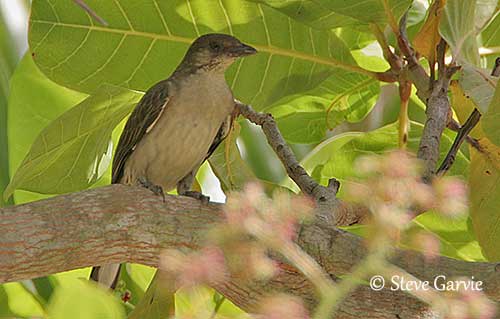
Greater Honeyguide
Female
Mainly immatures and females Greater Honeyguides appear to guide humans. They perch near humans and call repeatedly. From an observation, a female led observers to four separate nests. The bird repeats its insistent calling and moves frequently, displaying the white outer tail feathers. However, the Greater Honeyguide becomes silent in the vicinity of the bee’s nest and looks on at the humans. The honey-hunters traditionally leave a large part of honeycomb to the bird.
These birds are able to understand a human call and to lead them to locate honey. This behaviour gives the birds their names of “honeyguides”.
The honeyguides are nest parasites and aggressive. They are usually faster than their hosts that react aggressively to their approach. The host birds chase the intruders, but they are finally chased by the honeyguides.
From some observations, males and females monitor both activities and nests of their hosts. A male Lesser Honeyguide may acts in concert with the female, in order to help her to gain access to the hosts’ nest. The laying female may puncture or remove some host’s eggs. She lays her egg very quickly, only 10-15 seconds to lay and leave the nest.

The barbet species used as hosts can kill or hurt a honeyguide caught in their nest. But so far is known, the hosts do not remove the eggs of the honeyguide’s. The egg hatches between 12 and 18 days. The chick is naked, blind and weak, but it has a well-developed egg-tooth and small, sharp, curved “hook” on the tips of each mandible. It is able to move, cling and bit anything it touches, except the foster parents. The host’s eggs are destroyed or punctured one by one, and if nestlings are present, they are bitten and lacerated to death and are finally removed by their parents.
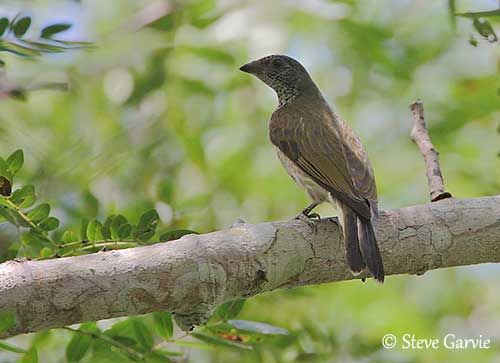
The young honeyguide begs loudly while it is fed by both foster parents. It growths thanks to the typical barbet diet such as fruit, but not wax. It fledges between 21 and 35 days after hatching, depending on the species. It is independent only two days after fledging.
It does not return to the nest for roosting, but quickly associates with other honeyguides and follows them to wax sources. The immature Greater Honeyguide differs from adults in plumage, with yellow-gold, cream and olive-brown plumage. It becomes immediately “superdominant” when arriving at bees’ nest, and may feed for 20-30 minutes.
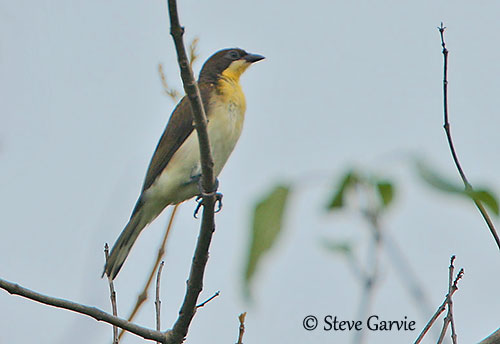
Greater Honeyguide
Immature
The Picidae Family belongs to the Order Piciformes. This family gathers Woodpeckers, Sapsuckers, Flickers, but also Wrynecks and Piculets.
The woodpeckers form the most important part of this family.
Picidae are widespread through the world, except in Madagascar, New Zealand, Australia and the poles.
The typical morphology features of this family include a strong, straight bill, a reinforced skull, short legs and strong feet for climbing, and stiff tail feathers. They have a very long tongue, adapted to their feeding habits.
The straight, chisel-like bill is made for excavating holes in tree trunks, and the reinforced skull is able to support repeated pecks against the wood. Short legs, strong feet and stiff tail feathers allow the birds to climb vertically and laterally along trunks and branches. The long, sticky tongue allows to probe deeply in bark crevices, in order to reach invertebrates and concealed larvae.
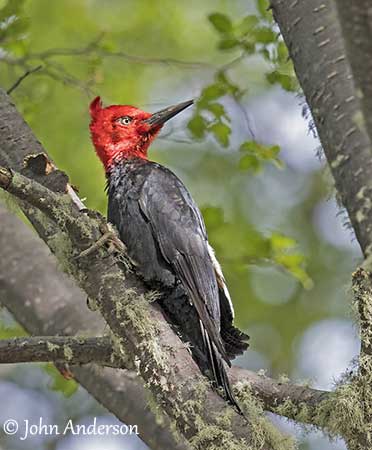
The woodpeckers regularly perform drumming. Both sexes drum, but mainly the male. Drums are closely related to territorial behaviour, as advertising calls in other bird’s species. The Woodpeckers only utter rattling calls and screams.
Woodpeckers are mainly arboreal species and usually frequent wooded habitats providing them suitable nest-sites because they are cavity nesters. However, other cavities such as rocky holes or crevices can be used by the Andean Flicker.
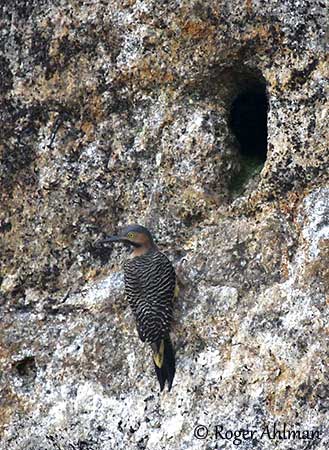
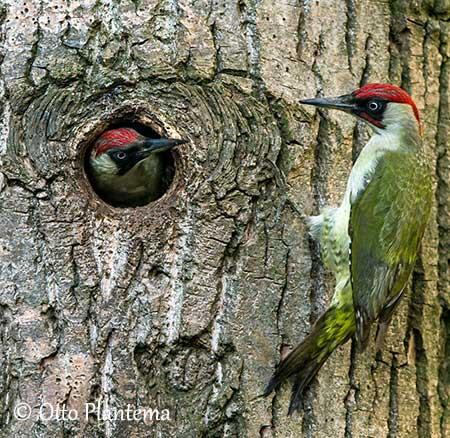
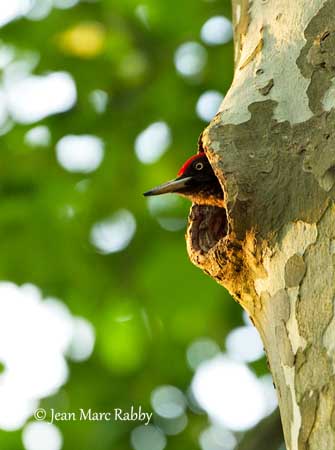
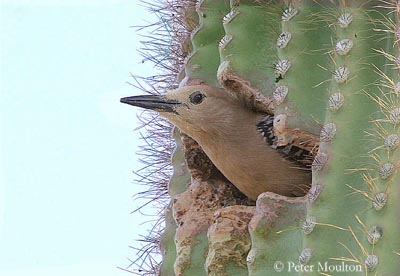
The Woodpeckers feed mainly on insects and larvae, other arthropods and caterpillars. They also consume nuts, fruits and tree sap. They reach the larvae thanks to their straight bill which excavates the crevices, searching for wood-boring insects.
Woodpeckers are good fliers, performing undulating flight, and most of them are sedentary in their range.
The Piculets are smaller than the other members of the family with less than 10 centimetres long. They differ in size, but also in the use of the tail when moving in the forest. They have a short tail with slightly pointed rectrices. While they are moving along the thin branches, or hammering strongly, the tail is only rarely used as support.
They have soft-coloured plumage, often brown to greenish with black markings. As in woodpeckers, the head pattern, orange or red in males and often white in females, makes the difference between the sexes.
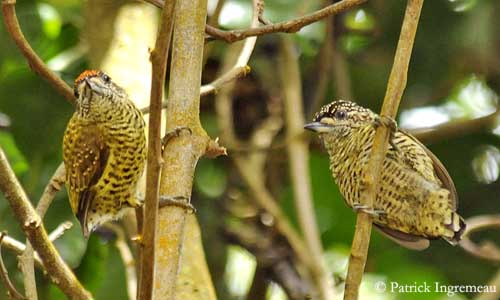
Golden Spangled Piculet
Male on the left and female on the right
They are able to excavate the nesting hole, thanks to the pointed bill laterally compressed.
Some species drum, and drumming can be regularly heard from these small birds.
The Piculets live in a wide variety of forested areas and woodlands such as rainforest or dry woodlands, plantations, mangroves, gallery forest, according to the range.
The most part of the Piculets is found in South America, but one species occurs in Africa, south of the Sahara, and some others are found in SE Asia to Java and Sumatra.
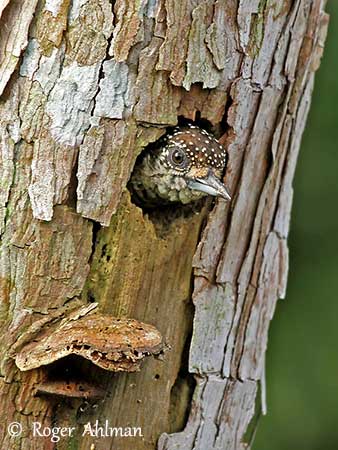
Their diet is relatively similar to that of woodpeckers, especially for the invertebrates, with boring insects and their larvae, caterpillars and spiders.
There is not information about their feeding behaviour, but some of them, better known, forage at various levels in forest. They are very agile and rapid, and can reach the tip of the thin branches.
The Piculets nest in holes excavated by both sexes. Some displays are observed with the male circling around the female, and chasing her among the branches. Some other displays include wing-spreading and synchronized movements.
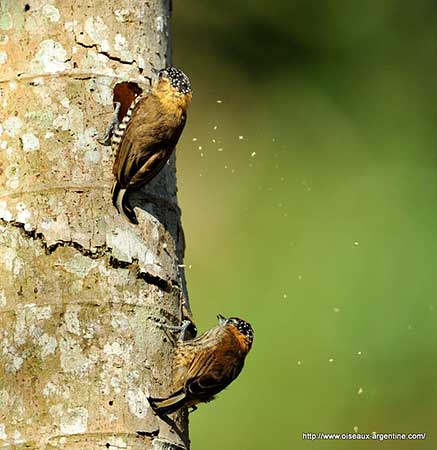
The brood ranges between 2 and 4 eggs. Both adults share the nesting duties. They defend the site and can peck at the intruders.
Most species seems to be resident in the range, and they are not globally threatened at this moment.
But these birds still are poorly known.
The Wrynecks belong to the Picidae Family, but their behaviour is slightly different. These birds do not drum, and they have not stiff tail feathers. They do not excavate tree holes, and prefer to use abandoned or occupied cavities, from which they eject eggs and nestlings before to adopt the hole. They are territorial and defend strongly the nest-site.
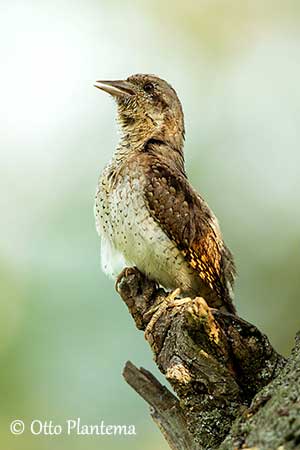
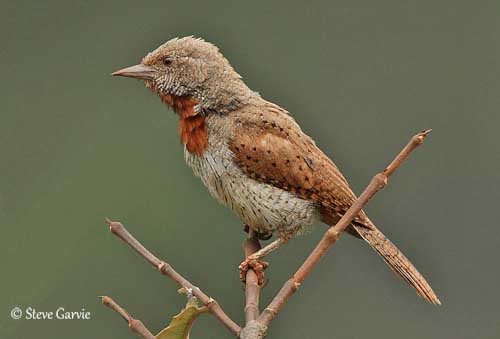
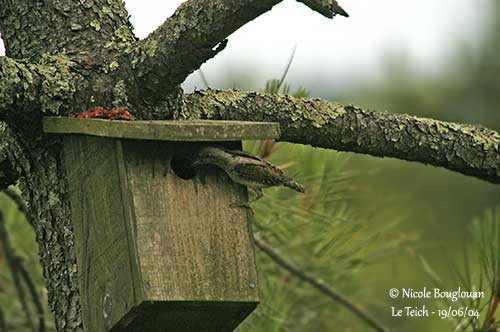
The female lays several white eggs and the incubation lasts 12-15 days. The young are fed by both parents with ants and their larvae and pupae. The adults deliver large beakfulls of this food to the nest.

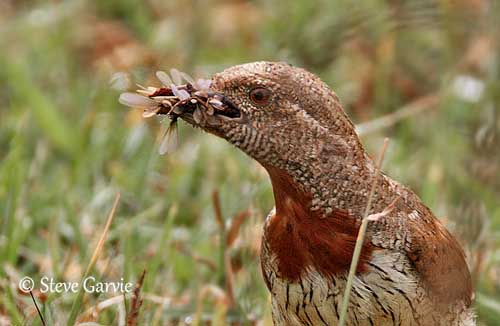
There are only two species, the Rufous-necked Wryneck from Africa, and the Eurasian Wryneck from temperate zones of Eurasia and Asia.
The nests of the Rufous-necked Wryneck are often parasitized by Indicatoridae species. This species is resident with some post-breeding dispersions, whereas the Eurasian Wryneck is migratory and spends the winter in Tropical Africa and in Southern Asia.
The family Ramphastidae includes toucans, araçaris and toucanets found in Neotropical regions, with the greatest diversity in Amazonia. They are closely related to the American barbets of family Capitonidae.
They are medium-sized to large birds with brightly-marked plumage and huge, colourful bill. They are remarkably uniform morphologically and divided into five genera.
They frequent forested woodlands from NC Mexico to W and E Argentina, but some species such as the mountain-toucans of genus Andigena, may reach the treeline in northern Andes. They need suitable trees with pre-existing nesting cavities.
All species have a long, deep, narrow bill, often brightly coloured, with small to large forward-facing serrations or “teeth”, and the culmen curves downwards at tip until forming a hook. The bill pattern is usually complex, with various multi-coloured marks, vertical bands or spots. The bill may appear very heavy, but it is extremely light and hollow.

The head is generally colourful too, with bare skin around the eyes extending on to face, lores and sometimes bill. They have a long tongue, brush-like towards the tip, well-adapted to their diet consisting primarily of fruits.
Male and female differ in bill length, longer in male, but most species does not show sexual dimorphism in plumage and colour of the bare parts. However, the female may sometimes appear duller than male.
These arboreal birds move by bounding, jumping, leaping or hopping upwards in tree branches, or by clinging to smaller branches, in order to reach fruits with the long bill. The huge, colourful bill is sometimes used to intimidate other birds, especially at food sources. They are primarily frugivorous, but insects and other animal food are caught to feed the young.
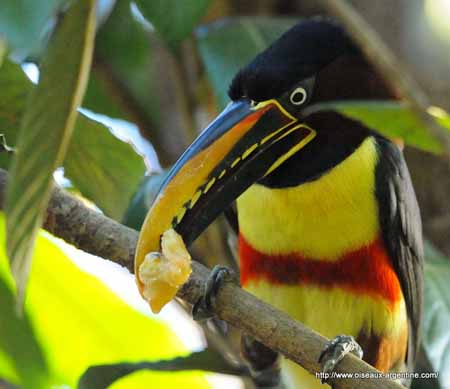
The largest species have an undulating flight, whereas the smaller ones fly more directly with fast wingbeats. The toucans do not perform aerial displays because their flight is usually rather weak.

They breed when great numbers of plants are fruiting. The Ramphastidae nest in cavities, but most of them are not able to excavate the hole, and they have to find a vacant cavity. They also may usurp a cavity during the nesting cycle of woodpeckers or other bird species.
The Toco Toucan is known to nest on or inside termite mound on the ground, often in the excavated cavity abandoned by the Campo Flicker. The big toucans of genus Ramphastos clean out debris and tear into rotted wood at the bottom of natural cavities. These holes used in several following years become deeper and deeper.
Some toucanets, mainly females, are able to excavate or bite out rotten wood, and drop the pieces of wood away from the nest. The Plate-billed Mountain-Toucan does some excavation to complete a nest, because the nesting cavity may be nearly two metres deep.

Toucans defend the nest and mob some predators, but more often, they remain at a distance.
Some displays are observed, but mainly courtship feeding. In long pair-bond species, the displays are not elaborate, and the birds mate without prior ritual. However, some toucans perform courtship displays that enhance their colourful bill and plumage.
The clutch contains 1-5 white eggs in green toucanets of genus Aulacorhynchus, 2-4 in Selenidera species, or 2-3 in Plate-billed Mountain-Toucan, 2-5 by araçaris and 1-5 by large Ramphastos species, laid at daily intervals.
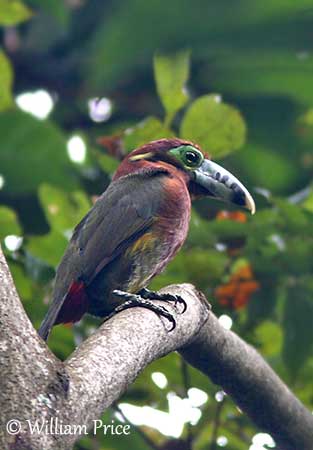
Female
The incubation is mainly by the female but the male may help depending on the species. This period lasts 15-17 days in toucanets, araçaris and mountain-toucans, and mostly 15-18 days in Ramphastos species. Both parents brood the chicks and feed them, sometimes by regurgitation. The nesting cavity is generally kept clean.
At hatching, the chicks are blind and naked. They have a badly proportioned bill with the lower mandible longer than the maxilla with bears the egg tooth. The nestling period is long. The feathers begin to appear at two weeks, whereas the eyes open in two to four weeks. They are well-feathered at four to five weeks old. They fledge about 40 days (at least) after hatching, but mainly 43-45 days in larger species, and even 46-60 days in Plate-billed Mountain-Toucan.

Nest's entrance